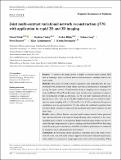Joint multi‐contrast variational network reconstruction (jVN) with application to rapid 2D and 3D imaging
Author(s)
Polak, Daniel; Cauley, Stephen; Bilgic, Berkin; Gong, Enhao; Bachert, Peter; Adalsteinsson, Elfar; Setsompop, Kawin; ... Show more Show less
DownloadPublished version (1.913Mb)
Publisher with Creative Commons License
Publisher with Creative Commons License
Creative Commons Attribution
Terms of use
Metadata
Show full item recordAbstract
© 2020 The Authors. Magnetic Resonance in Medicine published by Wiley Periodicals, Inc. on behalf of International Society for Magnetic Resonance in Medicine Purpose: To improve the image quality of highly accelerated multi-channel MRI data by learning a joint variational network that reconstructs multiple clinical contrasts jointly. Methods: Data from our multi-contrast acquisition were embedded into the variational network architecture where shared anatomical information is exchanged by mixing the input contrasts. Complementary k-space sampling across imaging contrasts and Bunch-Phase/Wave-Encoding were used for data acquisition to improve the reconstruction at high accelerations. At 3T, our joint variational network approach across T1w, T2w and T2-FLAIR-weighted brain scans was tested for retrospective under-sampling at R = 6 (2D) and R = 4 × 4 (3D) acceleration. Prospective acceleration was also performed for 3D data where the combined acquisition time for whole brain coverage at 1 mm isotropic resolution across three contrasts was less than 3 min. Results: Across all test datasets, our joint multi-contrast network better preserved fine anatomical details with reduced image-blurring when compared to the corresponding single-contrast reconstructions. Improvement in image quality was also obtained through complementary k-space sampling and Bunch-Phase/Wave-Encoding where the synergistic combination yielded the overall best performance as evidenced by exemplary slices and quantitative error metrics. Conclusion: By leveraging shared anatomical structures across the jointly reconstructed scans, our joint multi-contrast approach learnt more efficient regularizers, which helped to retain natural image appearance and avoid over-smoothing. When synergistically combined with advanced encoding techniques, the performance was further improved, enabling up to R = 16-fold acceleration with good image quality. This should help pave the way to very rapid high-resolution brain exams.
Date issued
2020Department
Harvard University--MIT Division of Health Sciences and Technology; Massachusetts Institute of Technology. Department of Electrical Engineering and Computer ScienceJournal
Magnetic Resonance in Medicine
Publisher
Wiley